Phone:
+1 252 794 3642
Location:
305 S King St
Windsor, NC 27983
KNOW WHAT YOU OWN
Maintaining Forest Property Boundaries With the value of timberland today, landowners would be well-advised to take sufficient steps to protect their investment. Maintaining property lines and boundaries is one of the simplest, yet most often overlooked forms of protection from theft, trespass and encroachment.
Why Identify Forest Property Boundaries? “Finding the corners” is typically the only way many landowners can identify their property boundaries. While simply locating and marking corners might suffice on residential properties, it is inadequate for forest property where corners can be thousands of feet apart. As a forest landowner, establishing and maintaining well-marked lines can save you money, liability and litigation. The following events require or are aided by well-marked and posted property lines.
Timber Sales Selling timber entails a precise location of the boundaries of a sale to conduct a legal and legitimate business transaction. Often times the costs involved in resurveying boundaries can be the highest cost of conducting a timber sale. However, survey costs can be deducted as a cost of sale for the re-establishment of exterior boundary lines. A survey conducted in a non-timber sale year should be capitalized (added to the land’s basis).
|
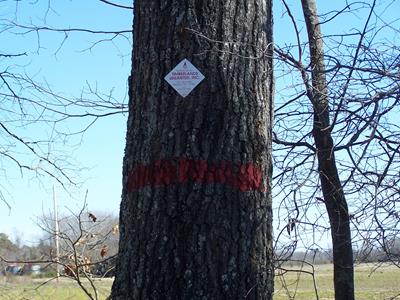
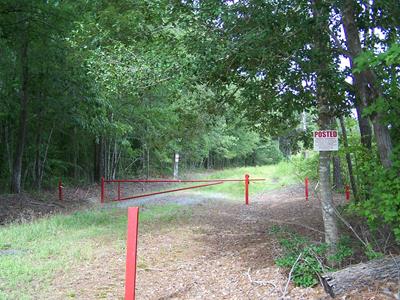
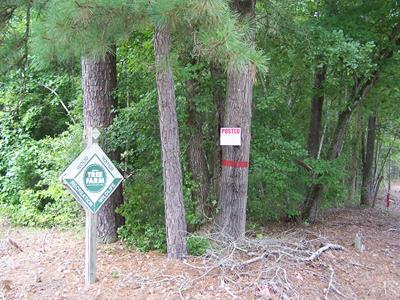
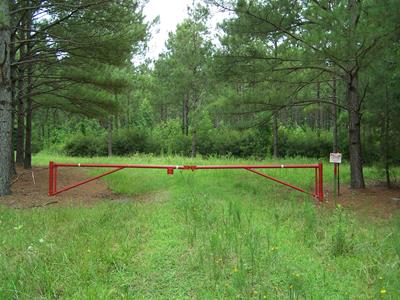
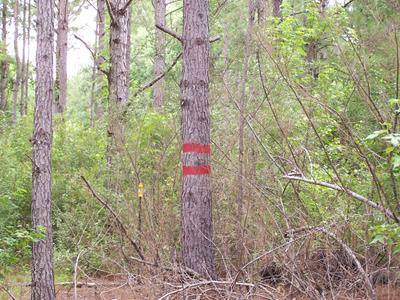
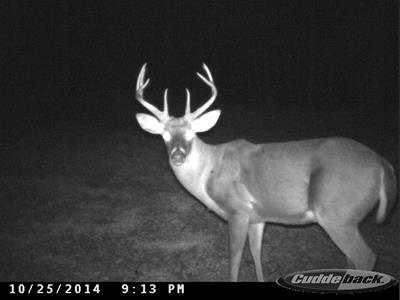
|
Subdivision or Property Transfer Each time that property is sold transferred or subdivided a Boundary Survey shall be conducted by a registered land surveyor to verify the location, extent and boundaries of property.
Covenants and Restrictions Some land parcels carry restrictions on the placement of buildings, setbacks for fences, or other limits on development. Identification of the exact location of property lines can aid in compliance with these restrictions.
Management Activities Timber harvesting, site preparation and prescribed burning operations must be conducted within the confines of one’s property. Clearly defined property lines will help avoid conflicts and potential encroachment on adjoining lands.
Trespass Unwanted trespass and poaching can be minimized by marking and posting property lines. In the case of hunting, trespass prosecution can only take place on lands upon which “posted” notices have been place. Gates should also be installed and maintained at all entry points.
Adverse Possession Unmarked property boundaries can lead to a loss of land. Land boundaries that are uncontested for a period of as little as 7 years can lead to loss of land by the original owner.
Timber Theft Unmarked property can be susceptible to timber theft (timber trespass). The best protection against timber theft is a well-marked, maintained boundary line.
Liability Property ownership comes with many responsibilities and obligations to invited and uninvited users. Well-marked or posted boundaries can help minimize landowner liability, especially in the cases of recreation and trail use where no fees are exchanged.
Where to Begin? The most efficient way to maintain property lines is to start after a recent survey has been completed, typically at the time of acquisition. Since many forest properties have remained in one family for decades, this may not always be practical. The next best option is to begin maintaining a line along a recently surveyed or harvested adjoining property, since adjacent ownerships share at least one common boundary. Subsequent lines can be marked following survey from timber sale or transfer. The cost of a survey can be deducted as a sale expense in the year of a timber sale only for that portion of the survey that defines a timber sale area.
Establishing Lines from a Deed Description In the absence of a recent survey the location of property corners and the distance and bearings can be obtained from a deed description available at the office of the Register of Deeds. Deed descriptions of the property should allow for an approximate location of most corners. Then, with the use of a compass, a helper, and a fiberglass tape, property locations can be made. One cautionary note for do-it-yourselfers; while any landowner or forestry consultant may establish a property line, they should do so with the understanding that they become responsible and thus, liable for damages due to any erroneous location. If there is any doubt, a professional survey is the only choice. (Note: State law prohibits the obliteration or movement of property corners even when the landowner believes it is incorrectly placed.)
Preparing Trees for Paint A draw knife or machete is used to scrape a smooth 5 to 6 inch band in the outer bark at roughly eye level. Working in two-person crews, the scraper can quickly prepare each tree for the painter following directly behind.
Painting Property Lines One widely used method for painting property lines uses a series of painted bands or blazes to mark line position and corners (see Figure 2). This method includes:
Well marked property lines can last for many years, but they should be checked for integrity at least once a year. Always check forestlands and property lines after severe storms, nearby harvesting, fire and during insect and disease outbreaks.
Summary The establishment and maintenance of property lines is a worthwhile investment that can yield many valuable dividends. Maintenance should begin directly after a survey for greatest benefit with the least cost. Also, a working knowledge of the North Carolina Statutes related to trespass and liability can greatly enhance your property protection efforts. Consult with a professional forestry consultant, licensed surveyor and attorney when dealing with property line matters as they impact your forestland. |
|
